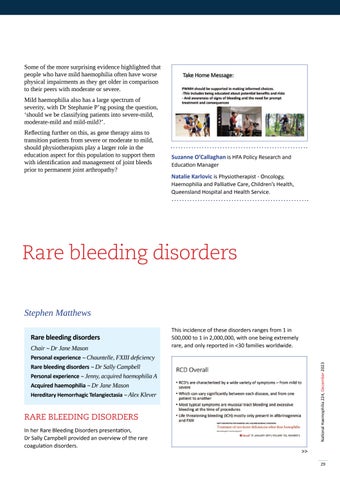Some of the more surprising evidence highlighted that people who have mild haemophilia often have worse physical impairments as they get older in comparison to their peers with moderate or severe. Mild haemophilia also has a large spectrum of severity, with Dr Stephanie P’ng posing the question, ‘should we be classifying patients into severe-mild, moderate-mild and mild-mild?’. Reflecting further on this, as gene therapy aims to transition patients from severe or moderate to mild, should physiotherapists play a larger role in the education aspect for this population to support them with identification and management of joint bleeds prior to permanent joint arthropathy?
Suzanne O’Callaghan is HFA Policy Research and Education Manager Natalie Karlovic is Physiotherapist - Oncology, Haemophilia and Palliative Care, Children’s Health, Queensland Hospital and Health Service.
Rare bleeding disorders Stephen Matthews
Chair ~ Dr Jane Mason Personal experience ~ Chauntelle, FXIII deficiency Rare bleeding disorders ~ Dr Sally Campbell Personal experience ~ Jenny, acquired haemophilia A Acquired haemophilia ~ Dr Jane Mason Hereditary Hemorrhagic Telangiectasia ~ Alex Klever
National Haemophilia 224, December 2023
Rare bleeding disorders
This incidence of these disorders ranges from 1 in 500,000 to 1 in 2,000,000, with one being extremely rare, and only reported in <30 families worldwide.
RARE BLEEDING DISORDERS In her Rare Bleeding Disorders presentation, Dr Sally Campbell provided an overview of the rare coagulation disorders.
>> 29











